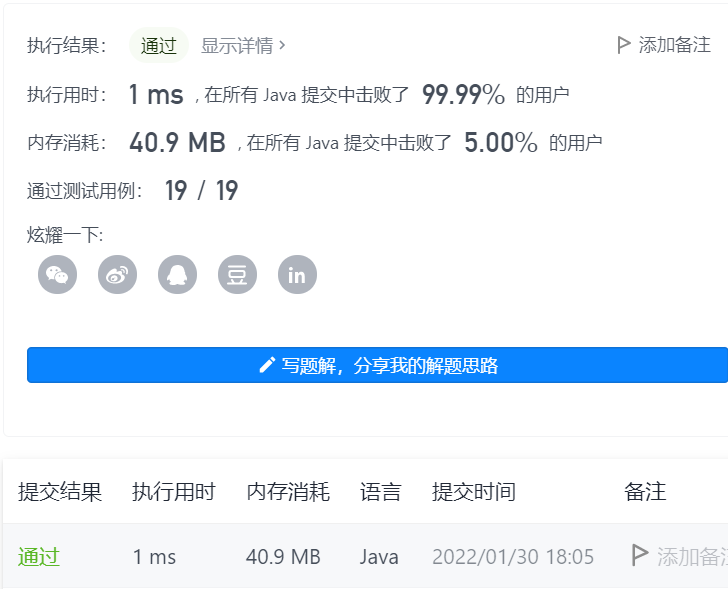LeetCode-209. 长度最小的子数组
题目来源
题目详情
给定一个含有 n个正整数的数组和一个正整数 target 。
找出该数组中满足其和 ≥ target 的长度最小的 连续子数组 [numsl, numsl+1, ..., numsr-1, numsr] ,并返回其长度。 如果不存在符合条件的子数组,返回 0 。
示例 1:
输入: target = 7, nums = [2,3,1,2,4,3]
输出: 2
解释: 子数组 [4,3] 是该条件下的长度最小的子数组。
示例 2:
输入: target = 4, nums = [1,4,4]
输出: 1
示例 3:
输入: target = 11, nums = [1,1,1,1,1,1,1,1]
输出: 0
提示:
1 <= target <= 1091 <= nums.length <= 1051 <= nums[i] <= 105
进阶:
- 如果你已经实现
O(n)时间复杂度的解法, 请尝试设计一个O(n log(n))时间复杂度的解法。
题解分析
解法一:双指针
- 本题是可以通过暴力法求解的,但是时间复杂度在,会造成超时。
- 这个题目需要注意的一个关键点就是“连续子数组”,看到连续,我们其实可以联想到双指针,因为双指针的本质就是通过两个指针来钳制住一个不断变动的区间。
- 如果使用双指针法,应该如何移动呢?实际上,我们需要维护的是区间内的元素和,当快指针前进时可以加上快指针的值,在移动快指针之前,可以尝试慢指针往前移动后是否会改变元素结果,使元素和仍然满足和大于等于target。
class Solution {
public int minSubArrayLen(int target, int[] nums) {
int start = 0, end = 0;
int n = nums.length;
int sum = 0;
int res = Integer.MAX_VALUE;
while(end < n){// 注意结束边界
sum += nums[end];
while(sum >= target){// 注意是while
res = Math.min(res, end - start + 1);
sum -= nums[start];
start++;
}
end++;
}
return res == Integer.MAX_VALUE ? 0 : res;
}
}
结果展示

Either Excellent or Rusty



【推荐】国内首个AI IDE,深度理解中文开发场景,立即下载体验Trae
【推荐】编程新体验,更懂你的AI,立即体验豆包MarsCode编程助手
【推荐】抖音旗下AI助手豆包,你的智能百科全书,全免费不限次数
【推荐】轻量又高性能的 SSH 工具 IShell:AI 加持,快人一步
· 阿里最新开源QwQ-32B,效果媲美deepseek-r1满血版,部署成本又又又降低了!
· 开源Multi-agent AI智能体框架aevatar.ai,欢迎大家贡献代码
· Manus重磅发布:全球首款通用AI代理技术深度解析与实战指南
· 被坑几百块钱后,我竟然真的恢复了删除的微信聊天记录!
· AI技术革命,工作效率10个最佳AI工具